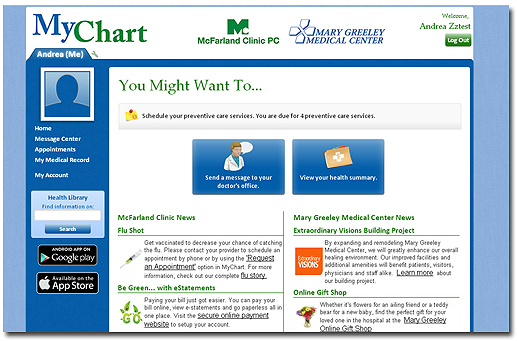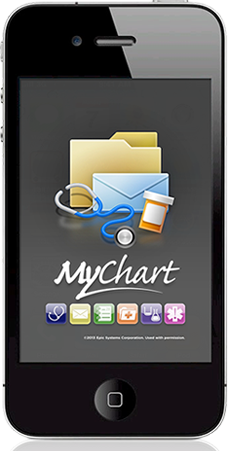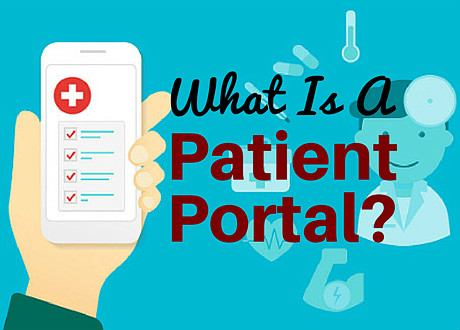As healthcare information technology has continued to mature, a notable area of growth has been the use of web and application-based patient portals. A patient portal is an application that allows patients to have access to parts of their medical records from their primary care doctor, specialists, or other Healthcare organizations. Patients log into patient portals from either a PC, a tablet, or a smartphone. The market for patient portals in the US is expected to reach over $2 Billion by 2020, up from about $279 million in 2012. (Source) Here are some functions and benefits of patient portals:
- View past and future medical visits
- View lab and other test results
- Request or directly schedule appointments with providers
- Request medication refills
- View current and past medications
- View immunization records
- View and update allergies
- Send and receive secure messages with provider’s office
- Receive text alerts concerning appointment changes and other updates
- Download copies of their own medical records
- Give access to family members to perform functions on behalf of a patient
One part of the medical chart that is not usually shared with patients is the physician progress note. The progress note is written in medical terminology, and is not directed toward the patient. A patient can specifically request to view progress notes through formal records requests, but this is not a routine practice for most patients. It’s most commonly done when a patient is working with a lawyer on possible legal action.
There is a growing movement called Open Notes that advocates for the more general release of physician progress notes. I expect that this trend will continue steadily, but I don’t have a prediction on when or if it will become the norm.
A patient usually gets access to a patient portal during an office visit with their provider. Since the patient is present, identity has already been verified. There are generally two ways patients can sign up for a new portal account:
- The provider’s office may have a PC or other workstation designated to allowing patients to create their account while at the office. At this time, they simply log in and create a user ID and password just like any other web account.
- If they don’t sign up while at the visit, they will be given a printout with instructions and a website address and a special authorization code that they enter in from home on the internet. The authorization code automatically expires if they don’t finish the process, usually from between 14 and 30 days.
Healthcare organizations who are trying to increase their portal sign-up ratio prefer the first option because it gets the sign-up process out of the way. With the second option, patients sometimes lose their sign-up instructions or forget to set up the account before the activation code expires.
Patient Portal Technologies – Types of Portals
From a technology perspective, it’s important to point out two different implementation models for patient portals:
EHR Patient Portal
In the EHR model, the portal is an extension of a vendor’s core electronic health record system. A Healthcare organization will usually launch the portal at the same time or shortly after the activation of the core EHR. Most of the data that patients see when they log into the portal is only from that organization’s system. Vendors are well aware of this limitation and are working towards providing the ability to bring in data from other Healthcare organizations. This is referred to as interoperability. It is however a work in progress, and various vendors and Healthcare organizations are at different stages.
EHR-Based Patient Portal Vendors:
| Vendor | Trade Name |
| Amazing Charts | Updox (also works with some other EHRs) |
| athenahealth | athenaCommunicator |
| Cerner | Cerner Patient Portal |
| eClinicalWorks | My eClinicalWorks |
| Epic | MyChart |
| Kareo | Patient Portal |
| MEDITECH | Patient Portal |
| NextGen | Patient Portal |
| Practice Fusion | Patient Portal (also has PHR) |
Most vendors who provide a patient portal allow the customers to re-brand it to their organization For example, Northwestern Medicine in the Chicago area has re-branded their Epic MyChart system to be called “My NM”.
Vendor Neutral Patient Portals
Next we have patient portals that are not tied to a specific electronic health records system, but are used to connect patients to their Healthcare providers. They have most of the same patient features as the EHR-connected portals, but are not tethered to a specific EHR. There are two advantages to these types of portals. 1) Clinics who can’t afford or don’t want to pay for a vendor-dependent portal can still get the functionality they need, 2) Patients who seek care from multiple providers can aggregate their health data into one portal. An example would be a patient who has a primary care physician in one organization who also sees a Cardiologist from another organization. As long as both providers participate in a standalone portal, the patient could aggregate their health data in one place.
Here are some of the leading vendor-neutral patient portals:
- Bridge Patient Portal*
- FollowMyHealth*
- RelayHealth
- Caradigm
- InteliChart*
(*These portals can also function as Personal Health Records)
Personal Health Records (PHRs)
Now we move to web-based health management tools that do not need to connect to EHRs. These are consumer-based tools that you have most likely heard of, and are marketed toward a broad audience. Patients enter most of their own data using features like these:
- Entry of doctor visits, medical history
- Messaging to participating Healthcare providers
- Entry of medications, allergies, etc
- Tracking of personal health goals
- Connectivity to fitness devices such as FitBit
- Connection to Smartphone Apps
While some of these systems may not connect to EHRs, some Healthcare organizations develop their own apps to get data from their systems to these patient-centered PHRs.
Here are some leading Personal Health Records
- Microsoft HealthVault
- MyPHR
- InteliChart
- FollowMyHealth
- Coral Health
Patient Portal Usage Statistics
-
Prefer to speak to health care provider directly: 76%
-
Did not have a need to use the patient portal: 59%
-
Concerned about the privacy/security of online medical record: 25%
-
Lack of access to the internet: 20%
-
No longer have an online medical record: 19%
Pros And Cons Of Patient Portals
Benefits of patient portals
-
More complete data in one place
-
Easier communication path with provider. No more phone tag
-
Faster access to data
-
Help with managing chronic illnesses
- Ability to download medical records in some cases
Disadvantages of patient portals
-
As with any written communication, portal messages can be misinterpreted
-
When patients have more access to the same lab results as providers, they can worry over ranges that may be label as ‘high’ but are not really a problem
-
Security risks
-
Disputes over sharing medical information with family members electronically. If portal access is shared between spouses involved in divorce or domestic conflict, patient information could be accessed or used improperly
Patient Portal Screen Shots



Patient Portals and Meaningful Use
Meaningful use is the Federal legislation that mandates the use of Healthcare Technology for most providers in the US. It has three stages phased in over several years. Each stage has requirements that increase from previous stages.
- Stage One (2011-2012): Data Capture and Sharing
- Stage Two (2014): Advance Clinical Processes
- Stage Three (2017 and beyond): Improved Outcomes
Part of Stage Three requirements involve the increased use of Patient Portals, which is gauged by two measures:
Measure 1: More than 50 percent of all unique patients seen by eligible providers during the EHR reporting period are provided timely (available to the patient within 4 business days after the information is available to the provider) online access to their health information.
Measure 2 – More than 5 percent of all unique patients seen by the eligible providers during the EHR reporting period (or their authorized representatives) view, download, or transmit to a third-party their health information.
Next Up:

Read More


